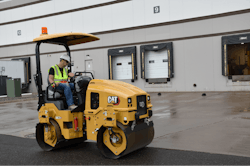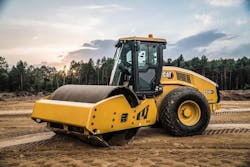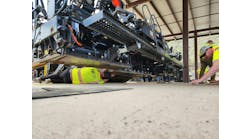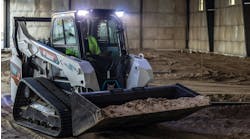By: Jack Roberts
At a virtual press event held at the Edwards Proving Grounds outside of Peoria, Illinois, JR Lorenzetti, global sales and marketing director, Caterpillar Paving Products, noted that while a lot has changed since CONEXPO-CON/AGG over a year ago, investments in new technology and product upgrades at Caterpillar never ceased: “Today, the fruits of those new investments are available for contractors with new, extended soil compactor product line with new GC models and new optional equipment, a refresh for our utility compactor line (with new models as well) and updates on our cold planer lineup.”
New GC Series Rollers
Dave Gerding, compaction specialist for vibratory soil compactors, launched an overview of the company’s new GC product line, making its North American debut.
“For Caterpillar, our new GC Series compactors are focused on simple operation, low operating costs, and improved compaction, which are the three leading demands from roadbuilding contractors, globally,” Gerding said. “Our focus on simple operation is based on the fact that compactors are usually introductory machines for novice operators with little experience. We want to help these new operators be productive. At the same time, we also realize contractors make money moving dirt and need to get their compaction jobs done as quickly and at the lowest cost possible in the fewest number of passes.”
To meet these needs, the new Cat GC compactors can handle 6- to 12-in. lifts and offer contractors more medium-size machine choices in applications where 200 cubic meters per hour in roadbuilding and site preparation applications are typical.
Cat’s expansion of its single-drum vibratory soil compactor line begins with the new 84-in. GC Series, with a lineup offering high static linear load and more weight at the drum for superior compaction, Gerding said. The new series consists of the 10-ton-class CS10 GC, 11-ton CS11 GC and CP11 GC, and 12-ton CS12 GC and CP12 GC. Gerding noted that both smooth and padfoot drum models are available for compaction of granular and cohesive soils.
The new GC Series is powered by a 120.7-hp Cat C3.6 diesel engine that meets U.S. EPA Tier 4 Final/EU Stage V emission standards. Standard Eco-Mode operation reduces engine speed to 2,000 rpm to deliver up to 10% fuel savings over operation at high idle.
Other new features include an “easy-to-select” speed control, which offers one-button switching from working to travel speed. Gerding said the machines all feature a single propel pump with limited slip differential rear axle to deliver excellent gradeability up to 55% for the 10- and 11-ton models and up to 50% for 12-ton models. All compactors feature a low overall 9.8-ft height plus improved tie-down locations for fast, low-cost transport that meets market regulations.
New Tandem & Combination Utility Rollers
Caterpillar’s line of utility compactors has received a product line refresh with the addition of 10 new tandem and combination models spanning the 2- to 5-ton weight classes, said Brian Nagel, sales support consultant. He noted that Cat has been continuously refining its utility compactor models for three decades, based on input from contractors and dealers: “It’s worth noting, because our soil compactors and utility compactors were developed and updated concurrently, there is a lot of shared DNA between the two machine families in terms of maintenance, operator station, and ergonomics. And we see that as a plus for our customers.”
According to Nagel, Cat’s utility compactor line will now use a weight-based nomenclature to differentiate models, beginning with the CB2.5 and going up to the CB2.9. “We’ve added larger engines to these models,” he explained, “with more engine options for different customer needs. And there are now fewer maintenance demands, in general, for them. Overall, they are very easy to maintain. They’re also very simple to operate without a lot of training, but still very productive with great compaction performance.”
The new models now give the utility compactor lineup compaction widths from 39 in. to 54 in., and feature large drum diameters for a smooth mat finish with thick drum shells for added durability. The rollers’ 2-in. drum offset improves compaction efficiency when rolling next to curbs, Nagel noted. And a narrow frame design allows for improved visibility to the job surface and drum edge. Optional compaction measurement value displays measured material stiffness to the operator, improving compaction performance, eliminating unnecessary passes, and improving consistency.
Both the standard and GC series models incorporate a water tank gauge for continuous monitoring from the operator’s station, so the tank does not run dry. Better positioned nozzles on the spray bars improve water coverage on the drum to prevent material pickup. The new spray test mode on the water system facilitates testing and adjusting nozzle angle to ensure proper drum coverage.
Customer-Driven Improvements for Cold Planers
Cat’s cold planer product line received an update a relatively short 18 months ago, according to Jameson Smieja, sales support consultant. But since those upgrades, Cat engineers focused on product updates to the company’s PM620, PM622, PM820, PM822, and PM825 half-lane cold planers. “This work includes numerous improvements based on customer feedback to ease operation and lower owning and operating costs,” Smieja said.
Chief among the enhancements are larger machines with higher horsepower engines for greater cutting ability and faster production on jobsites, improved safety features including better lighting, a more ergonomically designed operator’s station with an improved control layout, and easier access on and off of the machines. “These machines have a lot more power than their previous models,” he said. “You know they will deliver if you opt to push them to their maximum performance and can now easily mill much harder materials more efficiently.”
To illustrate the increase in engine power, Smieja noted that the 630-hp PM620 and PM622 models are powered by the Cat C18 engine. The heavier and more powerful PM820, PM822, and PM825 models are powered by the same C18 engine, he noted, but added that Cat has now added a twin-turbocharger for those machines to deliver 800 hp—up to 27% more power than the PM620 and PM622. All five models meet U.S. EPA Tier 4 Final, EU Stage V, and Korea Tier 4 Final emissions standards and are optimized to reduce fuel burn with a high-capacity cooling system that keeps the engine at ideal temperatures for optimal fuel efficiency and lower emissions.
Workplace safety around the new machines has been beefed up with redesigned lighting options that enhance nighttime and low-light operation. New, wide-dispersion LED work lights come standard and provide an improved, well-lit work area for ground crew. LED perimeter lights can also be added to further illuminate the rotor chamber, cutting path, and work areas around the machine for increased visibility. New entry/exit lighting provides illumination to the ladder and operator platform when the machine is off. The forward-folding canopy option now features dimmable LED strip lights mounted to the underside of the canopy to further improve visibility on the operator platform. When the canopy is lowered, the lights continue to illuminate the controls.
Once the machine is in action, Smieja said the integrated Cat GRADE with Grade and Slope system takes the guesswork out of producing accurate and repeatable cutting results and includes automated features like obstacle jump and programmable cut transitions to aid in milling precision. He added that Cat cold planers can also be enhanced with full 3-D milling operation.
The machines’ cutting system features heavy steel construction and reinforced alloys to resist abrasion. Available in a wide variety of spacings, Cat System K rotors are durable and deliver high performance with efficient material flow and an excellent cutting pattern. Kicker paddles are reversible for extended life, and the tapered dual retention toolholder design eliminates the need for retaining bolts, pins, or setscrews, reducing replacement time by up to 50%.
About The Author: Roberts covers the equipment side of our industry for Roads & Bridges.






